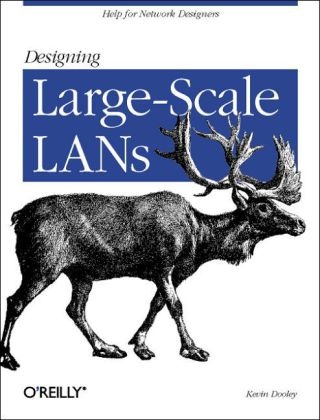Read more
This unique book offers a vendor-neutral approach for designing large local area networks according to business or organizational needs, rather than from a product perspective. Author and independent network design consultant Kevin Dooley outlines "top-down network design" for building a technological infrastructure to fit your organization's requirements, a process far more effective and cost-efficient than fitting the organization to the parameters of a shrink-wrapped proprietary solution.
Dooley argues that the design of a network is largely independent of the products used. Whether you use a Cisco or Juniper router, the same security issues and protocols apply. The questions he addresses in this book are need-specific: Do I use a router or a switch? Should I route between switched areas or switch between routed areas?
Designing Large-Scale LANs covers everything from security, bandwidth and scalability to network reliability, which includes backup, redundancy, and points of failure. Specific technologies are analyzed in detail: network topologies, routing and switching strategies, wireless, virtual LANs, firewalls and gateways, security, Internet protocols, bandwidth, and multicast services. The book also discusses proprietary technologies that are ubiquitous, such as Cisco's IOS and Novell's IPX.
This complete guide to top-down network design will help you choose the right network solutions. If you're designing large scale networks and need expert advice and guidance, look no further than Designing Large-Scale LANs.
List of contents
Preface;
Audience;
Organization;
Conventions Used in This Book;
Comments and Questions;
Acknowledgments;
Chapter 1: Networking Objectives;
1.1 Business Requirements;
1.2 OSI Protocol Stack Model;
1.3 Routing Versus Bridging;
1.4 Top-Down Design Philosophy;
Chapter 2: Elements of Reliability;
2.1 Defining Reliability;
2.2 Redundancy;
2.3 Failure Modes;
Chapter 3: Design Types;
3.1 Basic Topologies;
3.2 Reliability Mechanisms;
3.3 VLANs;
3.4 Toward Larger Topologies;
3.5 Hierarchical Design;
3.6 Implementing Reliability;
3.7 Large-Scale LAN Topologies;
Chapter 4: Local Area Network Technologies;
4.1 Selecting Appropriate LAN Technology;
4.2 Ethernet and Fast Ethernet;
4.3 Token Ring;
4.4 Gigabit and 10 Gigabit Ethernet;
4.5 ATM;
4.6 FDDI;
4.7 Wireless;
4.8 Firewalls and Gateways;
4.9 Structured Cabling;
Chapter 5: IP;
5.1 IP-Addressing Basics;
5.2 IP-Address Classes;
5.3 ARP and ICMP;
5.4 Network Address Translation;
5.5 Multiple Subnet Broadcast;
5.6 General IP Design Strategies;
5.7 DNS and DHCP;
Chapter 6: IP Dynamic Routing;
6.1 Static Routing;
6.2 Types of Dynamic Routing Protocols;
6.3 RIP;
6.4 IGRP and EIGRP;
6.5 OSPF;
6.6 BGP;
Chapter 7: IPX;
7.1 Dynamic Routing;
7.2 General IPX Design Strategies;
Chapter 8: Elements of Efficiency;
8.1 Using Equipment Features Effectively;
8.2 Hop Counts;
8.3 MTU Throughout the Network;
8.4 Bottlenecks and Congestion;
8.5 Filtering;
8.6 Quality of Service and Traffic Shaping;
Chapter 9: Network Management;
9.1 Network-Management Components;
9.2 Designing a Manageable Network;
9.3 SNMP;
9.4 Management Problems;
Chapter 10: Special Topics;
10.1 IP Multicast Networks;
10.2 IPv6;
10.3 Security;
Appendix A: Appendix: Combining Probabilities;
Glossary;
Bibliography;
Colophon;
About the author
Kevin Dooley is an independent networking consultant who hasbeen designing and implementing networks for more than ten years. In thattime he has built large scale Local and Wide Area Networks for severalof Canada's largest companies. He holds a PhD in physics from theUniversity of Toronto and is the author of Designing Large-Scale LANs.
Summary
This text offers a vendor-neutral approach for designing large local area networks according to business or organizational needs, rather than from a product perspective. Dooley outlines "top-down network design" for building a technological infrastructure to fit your organization's requirements.

